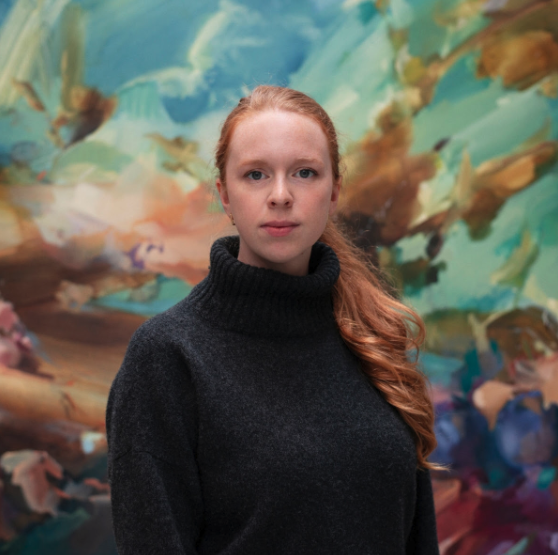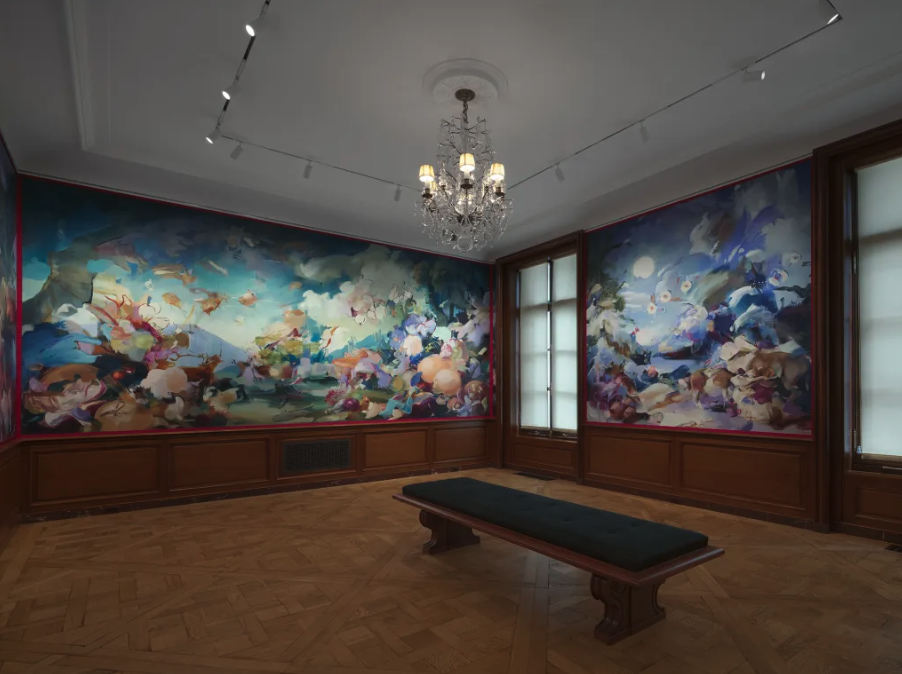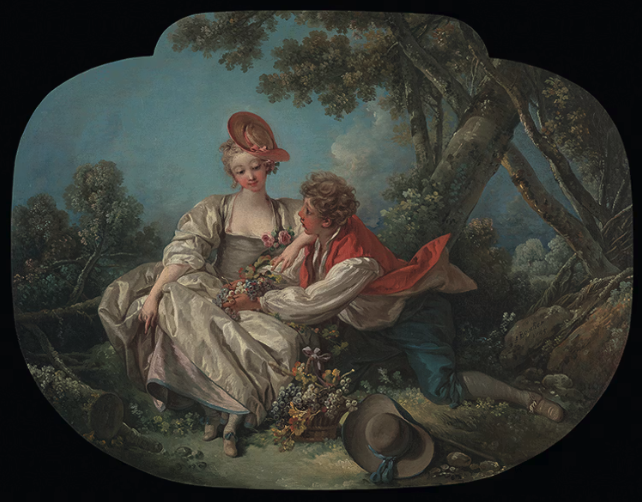Flora Yukhnovich Coast to Coast: From Gilded Age Manhattan to LA’s Right Now
Flora Yukhnovich. Photo: Kasia Bobula, courtesy the Frick Collection, New York
By J. SCOTT ORR OCT. 19, 2025
Flora Yukhnovich, the British painter whose work occurs at the unlikely intersection of Rococo and abstract expressionism, is having a moment—two of them, in fact, three thousand miles apart.
This fall, the 35-year-old Norwich-born painter spans centuries of art history with a site-specific mural installation amid the great masters of The Frick Collection in New York followed by the opening of, Bacchanalia, her first Los Angeles solo show Oct. 30 at Hauser & Wirth.
The Frick commission represents the museum's continued commitment to contemporary interventions—a strategy that proved wildly successful during its three-year exile at the Breuer Building five blocks away. The Frick’s residency at the brutalist fortress and former home of the Whitney lasted from 2021 until this spring, long enough for the museum to explore pairing living artists with the likes of Vermeer and Rembrandt.
Installation view of Flora Yukhnovich's Four Seasons in The Frick Collection's Cabinet Gallery, showing Autumn and Winter. Photo: Joseph Coscia Jr. courtesy the Frick Collection
Shows pairing Swiss artist Nicolas Party with 18th-century pastel master Rosalba Carriera, and especially Barkley L. Hendricks' life-sized portraits of Black Americans, drew crowds comparable to the institution's 2013 blockbuster that featured Vermeer’s masterpiece Girl with a Pearl Earring.
"We're not going to stop," curator Aimee Ng told me in 2024, as the Frick was preparing to return home to its ancestral home. "Contemporary art is one great way to continue to allow people to engage with our historic art."
Yukhnovich is the Frick's bet that this approach works not just at the Breuer but back in the rarified atmosphere of Henry Clay Frick's Gilded Age 5th Avenue mansion.
At the Frick, Yukhnovich takes over the Cabinet Gallery, known as the Boucher Room before the museum's recent renovation shuffled things upstairs. Her mural responds to 18th-century Rococo master François Boucher's The Four Seasons series from 1755—four paintings originally made for Madame de Pompadour depicting amorous encounters rather than traditional seasonal labors. Boucher's works, with their combination of luxury, seduction, and humor, found their way into Henry Clay Frick's collection in 1916 and now hang in the West Vestibule, where they resided when the Frick family actually lived in the mansion.
François Boucher's Four Seasons: Autumn (1755). Photo courtesy The Frick Collection, New York
Xavier F. Salomon, the Frick's Deputy Director and Peter Jay Sharp Chief Curator, who initiated the collaboration, noted that Yukhnovich's "clear admiration for the work of Boucher—an artist who is well represented in our collection—makes her a natural fit for this project."
"Painting this mural for the Frick has felt like stepping through one of Boucher's portals into a world that's both imagined and eerily familiar,” Yukhnovich said. “I wanted to create a continuous landscape that blurs the boundaries between past and present—a space where ornamentation, fantasy, and reality collide. It's been thrilling to explore how the language of the Rococo can speak so powerfully to our own curated, hyper-visual world."
Yukhnovich’s work pays due respect to Boucher, without a doubt, but there is also a time-shifting suggestion of the gestural violence of de Kooning as it might look rendered with the color saturation of an IPhone screen. There are rococo sensibilities and a varied color palette that ranges from soft pastels to saturated jewel tones. Then there is this compositional chaos that suggests the sensory assault of modern consumer culture and the visual vertigo of trying to process everything simultaneously while understanding nothing completely.
The installation images from the Frick show Yukhnovich’s signature approach upscaled to architectural dimensions. In it, the Cabinet Gallery's walls surrender to swirls of turquoise, peach, violet, and cream—clouds of paint that occasionally coalesce into something bodily, floral, or atmospheric before dissolving again. Still, the murals refuse to fight the mansion’s period details, like the chandelier hanging from the ceiling, instead settling for an uneasy detente.
The Frick commission isn't Yukhnovich's first institutional dialogue with Boucher. Last year at the Wallace Collection in London—which houses an extensive collection of the French master's work—curator Xavier Bray paired two of Yukhnovich's large-scale paintings with Boucher's monumental 1749 pastorals on the museum's high-traffic landing. The exhibition, which ran through November 2024, placed Yukhnovich's explosive abstractions directly alongside Boucher's languorous shepherds and aristocratic fantasies.
Flora Yukhnovich, Party in the U.S.A, 2025, will be part of her new solo show, Bacchanalia, opening Oct. 30 at Hauser & Wirth Downtown Los Angeles. Photo: Elisabeth Bernstein
Meanwhile, three thousand miles west, "Bacchanalia" at Hauser & Wirth further leverages Yukhnovich's engagement with excess and hedonism. The show features new large-scale canvases prompted by the ancient theme of Bacchanalian revelry—those wild Roman parties characterized by excesses of wine, sex, and divine frenzy. In her own way, Yukhnovich draws a modern-day comparison between the Roman orgies and the grotesquerie of today’s pop culture glut.
According to the Hauser & Wirth release, the paintings in Bacchanalia resist single focal points. Details get swallowed by a "cacophony of marks, where color and texture dominate the optical experience before forms can settle." Each painting suggests scenes that are simultaneously dissolving and coalescing—a visual state of flux that captures what the gallery calls "the precarious balance of seduction and alienation inherent in modern excess."
One key work, Party in the U.S.A. (2025), channels Hollywood via abstraction, taking the Columbia Pictures logo—that stately Torch Lady—as its departure point. What's left of the torchbearer is gestural at best, yet the panoramic format endures, conferring on those rolling clouds and classical allusions a scale that, per the gallery, "both suggests the glory of power and warns of its undoing."
Yukhnovich's working method involves pinning visual artifacts to mood boards in her studio—source images from across the cultural spectrum. As paintings evolve, key references emerge and shape the compositional and chromatic logic. The result is work that feels simultaneously researched and intuitive, calculated and loose. Though displayed a continent apart, the paintings in both exhibitions demonstrate this tension: lush, almost edible passages of paint adjacent to more aggressive, scraped-back areas. There's flesh in there somewhere, and flowers, and sky, but nothing stays put long enough to be named.
Her titles help locate the work culturally and across time: Warm Wet N' Wild (2020), Maybe She's Born With It (2022), are naked references to advertising copy and consumer culture even as the formal language of the work reaches back centuries. It's a balancing act—acknowledging that Boucher and Fragonard aren't neutral, that their paintings of women carry centuries of gendered looking and being looked at, while still claiming that formal language as available for reinterpretation.
Yukhnovich developed this approach while working on her MA at City & Guilds of London Art School, completed in 2017, following earlier portraiture studies at The Heatherley School of Fine Art in London. That training in traditional techniques shows—her paint handling has the confidence of someone who can actually draw and knows color theory.
The double exhibition strategy this fall demonstrates range. At the Frick, she's in explicit dialogue with the collection, working site-specifically within a historic institution that's testing whether contemporary interventions can work in a setting that screams Old Money and Older Art. At Hauser & Wirth, she's got room to push the work in a more explicitly contemporary direction, addressing themes of excess and consumption. Both shows foreground what Yukhnovich does best: using the visual language of art history to say something about now.
The Frick show will be accompanied by a volume in the museum's Frick Diptych series, featuring texts by both Yukhnovich and Salomon, to be published in February 2026. That kind of institutional embrace—the mural, the publication, the programming—signals that Yukhnovich has moved from emerging to established, and that the Frick is serious about making contemporary art part of its identity moving forward.
Whether that institutional warmth will dull the work's edge remains to be seen. For now, though, Yukhnovich seems to be pulling off the trick of making paintings that work both in Gilded Age mansions and contemporary white cubes, that reference Boucher and Party in the U.S.A. with equal conviction, and that manage to be about something—gender, power, excess, looking—without sacrificing visual pleasure. That's not nothing, especially when you're painting on the walls of one of New York's most tradition-bound institutions while it tries to figure out what it wants to be in the 21st century.
The installation at the Frick Collection, 1 E 70th St, New York, runs through March 9. The West Coast show runs Oct. 30-Jan. 18 at Hauser & Wirth Downtown Los Angeles, 901 East 3rd Street Los Angeles.
This article was originally published by Whitehot Magazine.




